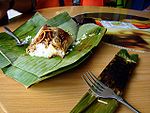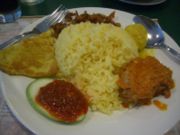
Nasi lemak
Encyclopedia

Brunei
Brunei , officially the State of Brunei Darussalam or the Nation of Brunei, the Abode of Peace , is a sovereign state located on the north coast of the island of Borneo, in Southeast Asia...
, Singapore
Singapore
Singapore , officially the Republic of Singapore, is a Southeast Asian city-state off the southern tip of the Malay Peninsula, north of the equator. An island country made up of 63 islands, it is separated from Malaysia by the Straits of Johor to its north and from Indonesia's Riau Islands by the...
, Riau Islands and Southern Thailand
Southern Thailand
Southern Thailand is a distinct region of Thailand, connected with the Central region by the narrow Kra Isthmus.-Geography:Southern Thailand is located on the Malay Peninsula, with an area around 70,713 km², bounded to the north by Kra Isthmus as the narrowest part of the peninsula. The...
. The dish is considered the national dish
National dish
A national dish is a dish, food or a drink that is considered to represent a particular country, nation or region.A dish can become a national dish for a variety of reasons. It can be the national dish because it is a staple daily food for the majority of the population. It can also be the national...
and a national heritage of Malaysia. It is not to be confused with Nasi Dagang
Nasi Dagang
Nasi dagang is a Malaysian and Southern Thai dish consisting of rice steamed in coconut milk, fish curry and extra ingredients such as fried shaved coconut, hard-boiled eggs and vegetable pickles.Nasi Dagang literally means "Trading Rice"...
sold on the east coast of Malaysia or Terengganu
Terengganu
Terengganu is a sultanate and constitutive state of federal Malaysia. The state is also known by its Arabic honorific, Darul Iman...
and Kelantan
Kelantan
Kelantan is a state of Malaysia. The capital and royal seat is Kota Bharu. The Arabic honorific of the state is Darul Naim, ....
although both dishes can usually be found sold side by side for breakfast. However, because of the nasi lemak's versatility in being able to be served in a variety of manners, it is now served and eaten any time of the day.
With roots in Malay culture, its name is a Malay
Malay language
Malay is a major language of the Austronesian family. It is the official language of Malaysia , Indonesia , Brunei and Singapore...
word that literally means "fatty rice". The name is derived from the cooking process whereby rice is soaked in coconut cream
Coconut milk
Coconut milk is the water that comes from the grated meat of a coconut. The colour and rich taste of the milk can be attributed to the high oil content. In many parts of the world, the term coconut milk is also used to refer to coconut water, the naturally occurring liquid found inside the hollow...
and then the mixture steamed. This is the same process used to make a dish from their neighboring country, Indonesia, which is nasi uduk. Therefore the two dishes are quite similar. Sometimes knotted screwpine
Pandanus
Pandanus is a genus of monocots with about 600 known species. They are numerous palmlike dioecious trees and shrubs native of the Old World tropics and subtropics. They are classified in the order Pandanales, family Pandanaceae.-Overview:...
(pandan
Pandanus amaryllifolius
Pandanus amaryllifolius is a tropical plant in the screwpine genus which is known commonly as pandan and is used widely in Southeast Asian cooking as a flavoring. The plant is rare in the wild but is widely cultivated. It is an upright green plant with fan-shaped sprays of long, narrow, bladelike...
) leaves are thrown into the rice while steaming to give it more fragrance. Spices such as ginger and occasionally herbs like lemon grass may be added for additional fragrance.
Traditionally, this comes as a platter of food wrapped in banana leaves, with cucumber slices, small fried anchovies
Anchovy
Anchovies are a family of small, common salt-water forage fish. There are 144 species in 17 genera, found in the Atlantic, Indian, and Pacific Oceans. Anchovies are usually classified as an oily fish.-Description:...
(ikan bilis), roasted peanuts, hard boiled egg, and hot spicy sauce (sambal
Sambal
Sambal is a chili based sauce which is normally used as a condiment. Sambals are popular in Indonesia, Malaysia, Singapore, the southern Philippines and Sri Lanka, as well as in the Netherlands and in Suriname through Javanese influence. It is typically made from a variety of chili peppers and is...
) at its core. As a more substantial meal, nasi lemak can also come with a variety of other accompaniments such as chicken, cuttlefish
Cuttlefish
Cuttlefish are marine animals of the order Sepiida. They belong to the class Cephalopoda . Despite their name, cuttlefish are not fish but molluscs....
, cockles
Cockle (bivalve)
Cockle is the common name for a group of small, edible, saltwater clams, marine bivalve molluscs in the family Cardiidae.Various species of cockles live in sandy sheltered beaches throughout the world....
, stir fried water convolvulus (kangkong
Ipomoea aquatica
Ipomoea aquatica is a semi-aquatic tropical plant grown as a leaf vegetable. It is known in English as Water Spinach, Water Morning Glory, Water Convolvulus, or by the more ambiguous names "Chinese spinach" and "swamp cabbage". It has many other names in other languages, such as "Phak bung" in Thai...
), pickled vegetables (acar
Acar
Acar is a type of pickling made in Indonesia, Malaysia, and Singapore. It is made from different vegetables such as yardlong beans, carrots and cabbage which are pickled in vinegar and dried chillies. The vegetables are then tossed in ground peanuts....
), beef rendang (beef stewed in coconut milk and spices) or paru (beef lungs). Traditionally most of these accompaniments are spicy in nature.
Nasi lemak is widely eaten in Malaysia and Singapore, even as a dish served in Malaysian schools. Commonly a breakfast dish in both countries, it is normally sold at hawker food centres in Singapore and roadside stalls in Malaysia. It often comes wrapped in banana leaves, newspaper or brown paper,and it could be served on a plate. However, there are restaurants which serve it as a noon or evening meals, making it possible for the dish to be eaten all day. Nasi lemak kukus which means "steamed nasi lemak" is another name given to nasi lemak served with steamed rice.
Different versions

Rendang
Rendang is a dish which originated from the Minangkabau ethnic group of Indonesia, and is now commonly served across the country. One of the characteristic foods of Minangkabau culture, it is served at ceremonial occasions and to honour guests...
and the addition of other seafood. Hawker centres in Singapore usually wrap them in banana leaves to enhance the flavour. Roadside stalls sell them ready packed, known as "nasi lemak bungkus", with minimal additions that cost between RM
Ringgit
Ringgit mostly refers to the Malaysian ringgit, which is the local currency in Malaysia, but it can also refer to the Brunei dollar or Singapore dollar in the Malay language. The word ringgit was originally used to refer to the serrated edges of Spanish silver dollars widely circulated in the area...
1–7 per pack. There are Malaysian Chinese and Malaysian Indian versions, and Singaporean Malay and Singaporean Chinese versions.
Malaysian Indian version
The Malaysian Indian version is similar to the original version. However, many Malaysian Indians are Hindus, and do not eat beef. Therefore, beef is not included while preparing the Malaysian Indian version of nasi lemak.Malaysian Chinese version
Although it is not common to see Malaysian ChineseMalaysian Chinese
Malaysian Chinese is a Malaysian of Chinese origin. Most are descendants of Chinese who arrived between the fifteenth and the mid-twentieth centuries. Within Malaysia, they are usually simply referred to as "Chinese" in all languages. The term Chinese Malaysian is also sometimes used to refer to...
stalls and restaurants selling nasi lemak, there is a non-halal version that contains pork sold in towns and cities such as Malacca
Malacca
Malacca , dubbed The Historic State or Negeri Bersejarah among locals) is the third smallest Malaysian state, after Perlis and Penang. It is located in the southern region of the Malay Peninsula, on the Straits of Malacca. It borders Negeri Sembilan to the north and the state of Johor to the south...
and certain parts of Kuala Lumpur. Some Malaysian Chinese hawkers are known to make minced pork sambal.
Riau Islands version
Similar to Malaysian version with a kind of small fish called ikan tamban, usually fried with sambal and very crispy, whole fish is edible.Singaporean Malay version
This traditional favourite offers ikan bilis (the Malay version of anchovies) and nuts, fried fish, cucumber and sometimes an egg.Singaporean Chinese version
Retaining the familiar aroma of pandan leaves, the Chinese variation comes with a variety of sides that includes deep fried drumstick, chicken franks, fish cake, curried vegetables and luncheon meat.Vegetarian version
In certain parts of Kuala Lumpur, some Malaysian Chinese and Malay hawkers also offer vegetarian nasi lemak in which the dried anchovies is substituted with vegetarian mock anchovies.See also
- Cuisine of MalaysiaCuisine of MalaysiaMalaysian cuisine reflects the multicultural aspects of Malaysia. Various ethnic groups in Malaysia have their own dishes, but many dishes in Malaysia are derived from multiple ethnic influences. Food preparation differs from place to place, although many of the foods used are alike...
- Cuisine of SingaporeCuisine of SingaporeSingaporean cuisine is indicative of the ethnic diversity of the culture of Singapore, as a product of centuries of cultural interaction owing to Singapore's strategic location...
- Mamak stallMamak stallA mamak stall, is a food establishment which serves mamak food. In Malaysia, the term mamak refers to Tamil Muslims, who generally own and operate them. Although traditionally operated from roadside stalls, some modern mamak stall operators have expanded their businesses into restaurant or...
- Nasi DagangNasi DagangNasi dagang is a Malaysian and Southern Thai dish consisting of rice steamed in coconut milk, fish curry and extra ingredients such as fried shaved coconut, hard-boiled eggs and vegetable pickles.Nasi Dagang literally means "Trading Rice"...
- Nasi uduk
- Nasi ulamNasi ulamNasi ulam is a steamed rice dish mixed with various herbs, especially the leaves of pegagan or often replaced with kemangi , vegetables, spices and accompanied with various side dishes...

